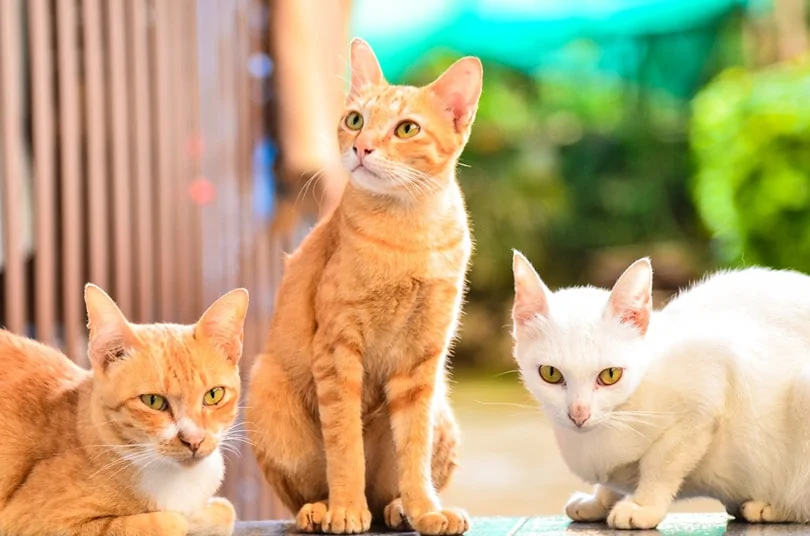According to Cristin Tamburo Coll, Certified Feline Behavior Consultant at The Cat Counselor in Los Angeles, cats are generally neat creatures.
“Cats are one of the few wild animals that can be both predator and prey.” They conceal their feces to hide the odor and avoid becoming a target for a predator.”
Because of such characteristics, litter training a cat is quite simple—certainly easier than potty training a dog, as cats have a natural proclivity to use the litter box once they know where to look.
How to Potty Train an Adult Cat
Choosing an adequate litter box and litter for your home, setting it in a safe designated position, and showing your cat where it’s situated are all important first steps when litter training a kitten.
However, there are a number of factors that influence how successfully your cat adjusts to using the litter box when you initially start training her.
Location of the litter box:
“Placing a litter box in a quiet and secure area of the house will help ensure that your cat uses his or her box on a regular basis.”
“Choose a location away from the home’s high traffic areas,” suggests Britt Gagne, Executive Director of Furry Friends Refuge in Des Moines, Iowa.
Cats, like people, do not want to eat where they eliminate waste, so keep that in mind when deciding where to put the litter box. “Often, food, water, and litter may be located in the same’safe zone’ of the house, out of the way of major traffic zones,” Gagne explains.
- The 15 Most Demanding Dog Breeds
- Young Adult Dog Breeds Top 10
- The Sharpest Pups Unveiling the Smartest Dog Breeds
- Zodiac Dog Breeds
“However, there should be at least 3 feet between the litter box and food and water.” For comfort and to provide a sanitary space to eat and drink, both animals and humans prefer that their food and drink not be stored near their bathroom.”
Remove litter:

Cats prefer order, therefore if you don’t clean the litter box on a regular basis, it will be a huge stumbling block in your cat’s training.
“Make sure that if a lot of dirty litter is removed, that enough new litter is added to allow the cat to dig and cover things in the box as they naturally want to do.
” Litter should be cleaned everyday and completely dumped and washed every seven to ten days, according to Gagne.
Number of litter boxes: If you have more than one cat in your home, they might not like sharing. To accommodate your pet, the simple approach is to add another litter box.
“The general rule is that each cat should have at least one litter box.” “It’s ideal to have one more than the number of cats in the household,” Gagne explains.
Bring Your Outdoor Cat Inside
Outdoor cats bury excrement in various outdoor materials such as grass, sand, or dirt. When bringing an outdoor cat inside for the first time,
litter training can be difficult because most types of litter have a different smell and texture than the cat is used to. It can be difficult at first to figure out how to get the cat to use the litter box.
“Recently, I had a client whose cat was going in the grass in the backyard, so we actually got the cat used to using the litter box by putting a piece of sod in the litter box.”
“We then began sprinkling the litter of choice on top and gradually increased the amount of litter until we transitioned that other substrate out of the box,” Tamburo Coll explains.
“Another thing you could try is multiple different boxes with different materials ‘buffet style’ to determine what they’re comfortable using.”
Because of potential diseases, some outdoor cat owners are hesitant to bring their cat inside. Fortunately, while cat excrement can be a source of salmonella or toxoplasmosis, adequate hand washing, protective clothing such as gloves, and not inadvertently eating the waste should be sufficient to safeguard cat owners in many cases.
“Fortunately, not many diseases are transferable from animals to humans,” Tamburo Coll explains. “However, best practice is to wash your hands frequently and avoid accidentally scooping the litter box and then touching your face.”
“Whenever you bring a cat in from the outside, take it to the vet for an overall health check and vaccinations.” [Outdoor cats] are usually a little grubby. Nothing too serious.”
Changing Litter Training Habits in an Elderly Cat
If you’ve adopted a senior cat or your current cat is becoming older, litter training may provide some age-specific issues.
A cat is considered senior when it is 10-12 years old, however this varies every cat and when they begin to show signs of age.
Senior cats might have health problems such as renal, liver, hearing, and eyesight impairments, among others.
Tamburo Coll recommends adding a nightlight in the area where your cat’s litter box is located to assist them discover it more quickly if they are having visual issues.
Cats can grow senile or experience deteriorating cognitive function as they age, making remembering where the litter box is placed more challenging. If they show signs of confusion, you may need to remind them where it is on a regular basis.
Arthritis, as well as bone and joint problems like as hip dysplasia, are rather frequent in elderly cats. Consider keeping the ideal litter box for your older cat low-sided and uncovered.
“While closed-top litter boxes may appeal to some pet owners more, open-top litter boxes are preferred,” Gagne explains.
“A closed-top box can make your cat feel uncomfortable due to enclosed smells and [feeling] trapped while in a vulnerable position, especially if your cat has a history of inappropriate urination.”
Cat owners are generally aware of their cat’s normal behavior. Overall, Tamburo Coll recommends taking your cat to the doctor for a checkup if they are exhibiting any changes in behavior or attitude, such as having accidents, seeming tired, moving more slowly, or having difficulty getting around.
Why Do Cats Sleep In Their Litter Boxes?

Have you ever noticed your cat dozing off in the litter box? While this unusual behavior is more typical in senior cats, it can occur in cats of any age.
Among the factors that encourage cats to sleep in the litter box are:
Stress and anxiety: Cats who have come from a shelter or who have relocated to a new household may be yearning for a familiar fragrance to help them relax.
“As gross as it is, [the litter box] smells like them, and they prefer to be in places that make them feel safe,” Tamburo Coll explains.
Privacy:
The litter box, like humans and the precious alone time that (typically) comes with using the bathroom, may be a quiet area where cats take sanctuary from the rush and bustle of their home.
Bowel problems: It may be more difficult for senior cats to physically go to the potty. On the other side, they may need to go regularly and may be afraid to leave the box because they may need to go again shortly.
If your cat is sleeping in the litter box, you should have them checked out by a veterinarian. “If the veterinarian has ruled out any health issues, the next step is to assess any changes in the environment at home,” Tamburo Coll explains.
- The 15 Most Demanding Dog Breeds
- Young Adult Dog Breeds Top 10
- The Sharpest Pups Unveiling the Smartest Dog Breeds
- Zodiac Dog Breeds
“Try moving a cat tree or cat bed near the box to make the area around the box more comfortable for them.” This allows them to avoid sleeping in the box.”
Help! My Cat Is Still Refusing to Use the Litter Box

If you’ve tried everything to convince your cat to use the litter box and are still having trouble, Tamburo Coll’s first suggestion is to take the cat to the veterinarian.
In addition to your cat’s regular once-a-year exam, this is an excellent idea each time you observe a change in litter box habits or behavior.
“Cats are excellent at concealing signs of illness for extended periods of time.” “This relates to their position in the food chain as both predator and prey,” she explains.
“If your vet says nothing is wrong medically, contact a veterinary training behaviorist or a certified feline behavior consultant in your area.”

